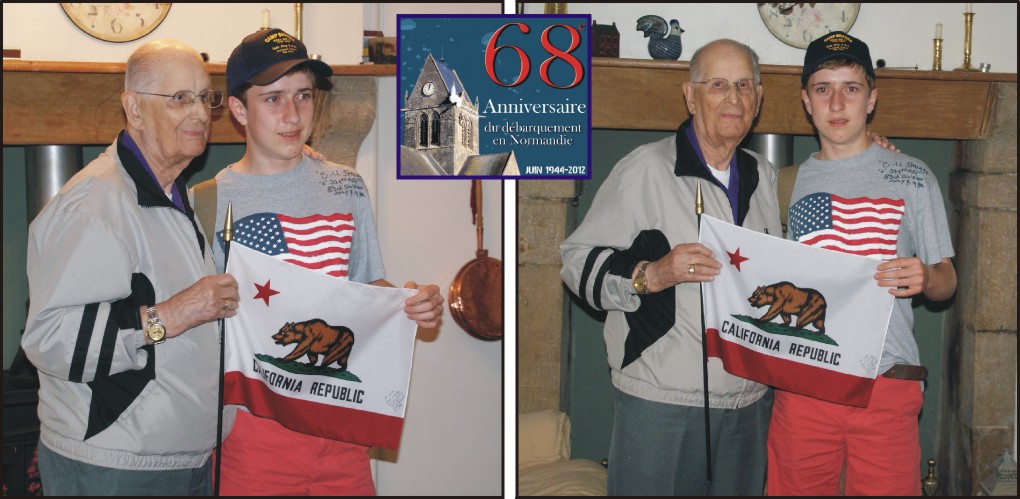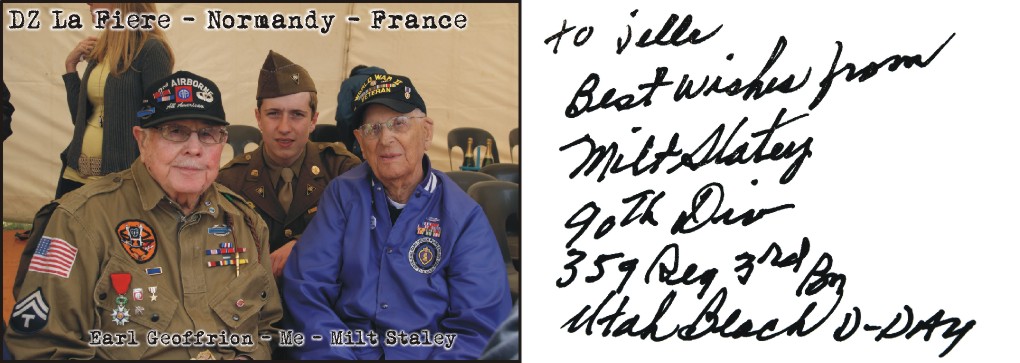I met Milton L. Staley, born in 1919 in Grand Rapids, Minnesota, at the Ceremony on the Monument dedicated to the 90th Infantry Division in Picauville, Normandy, on June 3, 2011.
Milt Staley, 92-year-old, was back in Normandy for the first time. ”He retracing his steps and marking the 67th anniversary of the D-Day invasion”: he said.
"I was very excited," about coming back, he said. It's the first time he has returned to Normandy since the war. "This is going to be my first return trip and my last," he said.
With two Purple Hearts, a Silver Star and a Bronze Star to his credit, Milt Staley might have a hard time convincing people he's not a hero. A very hard time.
"I was just one of a million guys doing his job," he said.
Milton L. Staley, saw a lot of combat while in the U.S. Army, serving in both the South Pacific and European theaters during World War II.
He was onboard the troop carrier SS President Coolidge on October 26, 1942, when it hit two of the U.S. Navy's own mines and sunk near Luganville harbor on the island of Espiritu Santo in Vanuatu. Two men, including the ship’s captain, died in the blast.
Drafted by the Army in the spring of 1942 after initially being refused enlistment because of poor eyesight, Staley was 23 when he found himself onboard the SS President Coolidge headed for Guadalcanal.
As the ship entered the mined harbor, Staley said, he first thought the Coolidge had been torpedoed.
“I was one scared soldier,” he said.
After it became clear that the Coolidge was not under attack but had run over two mines, its more than 5,300 men, including Staley, were ordered to abandon ship.
“There were so many people in the passageway that I couldn’t get through,” Staley recalled.
As the ship badly tilted to one side and began to sink, Staley said he eventually was able to climb down a rope ladder and jumped into the harbor’s water and swam to shore, cutting his feet on coral as he finally walked to safety.
Staley, who spent five months on the island after his ship sunk, contracted malaria and jaundice, and remained in the South Pacific until 1943 when he finally recovered and was sent to Europe, just in time for D-Day.
He was also there at Normandy during the D-Day invasion on June 6, 1944, and later fought in the Battle of the Bulge in 1945.
"I don't think it's a day anybody (who) was there will forget," Staley said.
Staley’s light weapons platoon landed on Utah Beach only a few hours after the initial assault and corpses littered the beach as German snipers and enemy artillery continued to attack U.S. and Allied troops.
Staley’s brother Vern, who died about two years ago, was with the 101st Airborne Division at the time and was dropped behind Utah Beach in the early morning hours of the invasion to help direct fire for a battleship.
Although Staley was not injured in the amphibious landing, he was wounded by enemy mortar shrapnel six days later and wounded again by either mortar or grenade shrapnel during the fierce Battle of the Bulge.
He later earned his Silver Star for gallantry after his company was stopped by an enemy attack near Beckenhun, Germany, and Staley crawled 50 yards over an open and fire-swept field to a point where he could better observe enemy gun positions and direct accurate mortar fire to destroy them.
Following the war, Staley returned to Minnesota, married his childhood sweetheart Doris, worked as a resident deputy sheriff, began to raise a family and moved to Southern California in 1950. The family moved to Shasta County from Covina after he retired from Philips Norelco following an 18-year career with the company where he was its eight-state western service manager.
He and his wife of nearly 53 years, who died in 1988 at age 77, owned Continental Meat in Redding for about eight years until they sold the business in 1980.



